Search the Special Collections and Archives Portal
Search Results
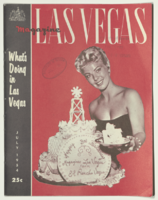
Magazine Las Vegas, volume 5, number 7
Date
Description
Mixed Content
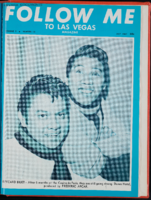
Follow Me to Las Vegas Magazine
Date
Description
Follow Me to Las Vegas, a magazine about art, entertainment, and popular culture in Las Vegas, Nevada. Entertainers and actors are featured in various articles and photographs. The magazine contains several print advertisements of local businesses and organizations.
Mixed Content
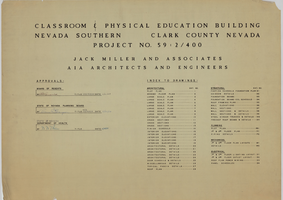
Nevada Southern University classroom and physical education building: architectural drawings
Date
Archival Collection
Description
From JMA Architecture Studio Records (MS-00783) -- Architectural drawings file.
Image
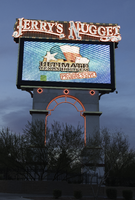
Photographs of Jerry's Nugget Casino sign, Las Vegas (Nev.), March 17, 2017
Date
Archival Collection
Description
Site address: 1821 N Las Vegas Blvd
Sign owner: The Stamis Family
Sign details: In 1964, Jerry Stamis and Jerry Lodge opened Jerry's Nugget Casino. The property, formerly the Towne House Bar, was converted into a casino. Four years after its opening, the owners bought the nearby Bonanza Club along with its sign, adding an additional 10,000 square feet to their property. The site has undergone numerous renovations, including in 1982 when it became a full-service casino complete with a restaurant, bars, and nearly 700 slots. The porte cochere was also added at that time. In 1996, a theatre lounge was added as well as a bakery and even more gaming tables. The casino, which celebrated its 50th anniversary in 2014. This location still claims to cater to "locals." Currently, it consists of slots, table games, keno lounge, and a bingo hall, among other popular features.
Sign condition: About 4-5, appears to have relatively low damage
Sign form: Sculptural pylon
Sign-specific description: Neon sign looks to be in the form of an oil derrick, "Jerry's" in a nugget shape at the top, "Nugget" spelled downward in light blue neon, possibly was once orange.
Sign - type of display: Neon
Sign - media: Steel
Sign environment: Located in North Las Vegas along Las Vegas Blvd, near the Silver Nugget Casino.
Sign - date of installation: 1964 for most of the signage for the property
Sign - date of redesign/move: 1982 Porte Cochere added with expansion
Sign - thematic influences: The signage conveys the Old West theme of striking it rich with gold, silver or oil, as they have an oil rig for portion of their sign.
Survey - research locations: Neon Museum tour outline, Jerry's Nugget website http://www.jerrysnugget.com/ , recorder's office, Assessor's page
Survey - research notes: For the 50th anniversary of their Company they donated the money for the restoration of their sign which is showcased on the documentary "Restoration Neon" and remains in the Neon Museum.
Surveyor: Carlyle Constantino
Survey - date completed: 2017-07-12
Sign keywords: Neon; Steel; Pylon; Incandescent; Back to back; Reader board; Video screen
Mixed Content
Kent Carmichael oral history interview
Identifier
Abstract
Oral history interview with Kent Carmichael conducted by Stefani Evans on November 25 and December 2, 2019 for the Boyer Early Las Vegas Oral History Project.
In the first session of this oral history, Carmichael discusses his early career in lighting design and maintenance from his start at Interstate Neon to his work in the 1950s and 60s in Las Vegas. He discusses some of the iconic signs he built including the Casino Center, Carnival Room, Thunderbird, The Frontier, Bonanza, and the Stardust. He also details the technology and inner workings of these innovative signs including the transition from mechanical to electrically controlled signage. Carmichael continues to discuss Native American laborers and various individuals that he interacted with throughout his early career including Max and Mo Oggenblick, Doby Doc, Benny Binion, Arby Alper, Steve Wynn, Peter Arp, and Wayne and Jerry Newton. Carmichael ends the first interview by recalling a high wind event that damaged the Frontier sign and his efforts to bring the sign under control and repair it as well as his vision and behind the Stardust sign.
The second oral history interview contains Carmichael’s discussion of his career from 1968 onward. He immediately picks up discussion of the Stardust sign and his transition to desk work. Carmichael details the challenge and limitations of designing the International sign (the Westgate as of 2021). He describes the development of his first messenger sign for the International and the time consuming task of using tape to program the sign. He fondly remembers working on the Holiday Inn Riverboat signs, and International transition to Las Vegas Hilton and the Hilton’s transition from blue to red letters. Carmichael shares the story of being caught between organized crime and a young Steve Wynn. He recounts his last project for Ad Art, developing and construction the sign for the Louisiana Superdome in New Orleans, Louisiana. He details working through legislative and construction issues as well as the fallout from the Nat Kiefer Commission.
After leaving Ad Art Carmichael began working with Heath and Co. and began collaborating with Raul Rodriguez. Carmichael and Rodriguez went on to design some of the most enduring and visually unique signs in Las Vegas including, the Flamingo, Four Queens, Golden Nugget, Dunes Hotel, and the Desert Inn. They also worked in Reno on Circus Circus and El Dorado. Carmichael also details his interior work including the main pylon and interior signs for MGM Grand; 1974 renovation Golden Nugget, suspended stained glass ceiling at Tropicana, and the MGM Lion display. Lastly Carmichael outlined his work with Young Electric Sign 1983-85 and the Dewey Sign Company including the Las Vegas Convention Center sign. He ends by sharing his views on the role and importance of lighting in Las Vegas.
Archival Collection

Transcript of interview with Willie Jones, James Jones, and Jamet Jones by Robbin Mc Laurin, March 5, 1980
Date
Archival Collection
Description
On March 5, 1980, collector Robbin McLaurin interviews three members of the Jones family, Willie, James, and Jamet Jones (born 1923, 1920, and 1961, respectively) in the Jones home. Mr. and Mrs. Jones were born in Forest, Mississippi, and relocated to Las Vegas, Nevada, for employment related purposes. This interview covers Las Vegas, past and present.
Text

Transcript of interview with Dale Duane Everett by John Everett, March 7, 1980
Date
Archival Collection
Description
On March 7, 1980, John Everett interviewed his father, cab driver Dale Everett (born January 29, 1924 in Danville, Illinois) at their family home in Las Vegas, Nevada. This interview covers past local historical data. During the interview, Mr. Everett discusses the weather, wildlife, and hunting. He also shares his views on prostitution and gambling in Las Vegas.
Text

Transcript of interview with Mary Ellen Campbell by Ronald Robinson, March 6, 1977
Date
Description
On March 6, 1977, Ronald Robinson interviewed Mary Ellen Campbell (born 1886 in Panaca, Nevada) about her life in Nevada. Campbell first talks about her parents’ move to the United States from England and her own life growing up in Panaca. She also talks about living in Pioche and the conditions of living in these two small Nevada towns. Also present during the interview is Mary’s grandson, Allen Campbell, who sometimes asks a few questions as well.
Text
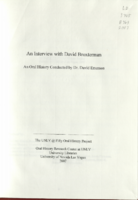
Transcript of interview with David Broxterman by Dr. David Emerson, October 24, 2007
Date
Archival Collection
Description
Text

